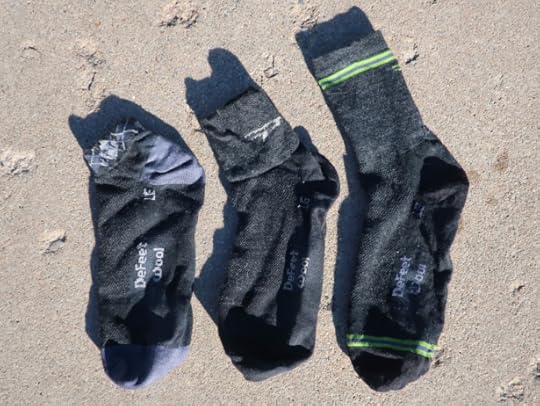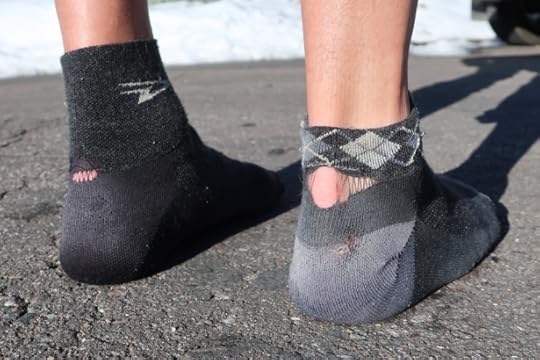Long-term review: DeFeet Wooleator Sock || Go-to sock for a decade-plus

In December I visited my parents in Massachusetts, and my mom had waiting for me a box of possessions that I needed to bring back to Colorado or throw out. Along with newspaper clippings from the Sea-to-Sea Route, a Valentine’s Day card from a high school sweetheart, and running logs from the pre-Strava era, I found some clothing and equipment from the Great Western Loop in 2007, including a pair of DeFeet Wooleator socks.

A blast from the past. For the entire 6,875-mile Great Western Loop (which earned me “Adventurer of the Year” honors from National Geographic Adventure), I wore the 3-inch Wooleator. Every 600 miles I received two fresh pairs. In this photo they’re out view, hidden by my gaiters and GoLite shoes (which I most definitely am no longer wearing).
Long-term review: DeFeet Wooleator Socks
A decade later, my go-to sock is still the Wooleator, which is a non-padded, thin sock made of 61 percent USA merino wool, 37 percent nylon, and 2 percent spandex. All told, I have hiked and run at least 20,000 miles in the Wooleator. I ran 4,000 miles in them just last year.
The Wooleator shares a similar construction to DeFeet’s original classic, the Aireator, which uses polyester fiber instead of merino. The top of both socks is a highly air-permeable mesh, which improves the dissipation of heat and moisture.

The Wooleator (and its polyester equivalent, the Aireator) has a mesh top that dissipates heat and moisture more quickly than non-mesh areas of the sock.
Optimal uses
I wear the Wooleator for:
Backpacking and hiking in 3-season conditions;
Road and trail running year-round, with temperatures as low as the single-digits;
Alpine skiing, as a liner sock inside my plastic boots; and,
Nordic skiing and snowshoeing, as a liner sock beneath the warmer DeFeet Woolie Boolie socks and sometimes a vapor barrier liner sock.

I use the 1-inch Argyle version for running in warm temperatures, like the 2017 Boston Marathon with 70-degree temperatures. They are the fastest looking iteration of the Wooleator.
I use the Wooleators for casual purposes, too, except if I’m wearing flipflops or brown dress shoes. They can be worn with black dress shoes, no problem, although my wife dislikes the pairing on principal.
Don’t ask me to compare the Wooleators to other hiking and running socks from Darn Tough, Smartwool, DryMax or others brands — I’ve never been compelled or curious to try them. If it ain’t broke, don’t fix it, I suppose.
In addition to its performance, the Wooleator offers another perk: it’s made in the USA, like all DeFeet products. Since 2005 I’ve been a grassroots brand ambassador for the Hildebrand, North Carolina-based company, receiving a few pairs of socks and wool Duragloves each year in exchange for sharing my experience with clients and readers.

The 5-inch version is best for cooler temperatures. It provides more ankle and lower-calf coverage, and ensures no gapping between shoes and running tights. It’s also an effective liner sock beneath a thicker insulating sock, and optional VBL sock.
Versions
There are several versions of Wooleator, with the only difference being the cuff height. I wear the:
1-inch Argyle for 3-season running, because they insulate the least and look the fastest;
3-inch D-Logo for backpacking and ultra marathon races, because they cushion my shins from my hiking gaiters and they seem less vulnerable to debris entering the sock than the 1-inch Argyle; and,
5-inch HiTop for colder temperatures, when I need to cushion my lower-calf from tall boots and to cover fully the gap between my running tights and shoes.

Three versions of the Wooleator: 1-inch Argyle, 3-inch D-Logo, and 5-inch High Top. Each version excels in a particular application and set of conditions.
Winning characteristics
Why do I keep wearing the Wooleator, mile after mile and year after year?
1. Wearable range
The Wooleator performs excellently for nearly all of my purposes. One sock and done.
The only notable exception is when big game hunting in the Colorado Rockies in October or November, when I find that one pair of Woolie Boolies work best — it’s too cold for the Wooleators on their own, but not yet cold enough for Wooleators+Woolie Boolies.
2. Moisture management
After becoming wet with perspiration, submerged in a snowmelt-fed creek, or washed during a rest stop, the Wooleators dry quickly and retain little moisture. They are thin and unpadded, and consist mostly of hydrophobic fibers like merino wool and nylon (with a tiny bit of spandex and no cotton).
Moisture management performance is not as good as a pure synthetic sock like the Aireator, but overall I think the tradeoffs are worthwhile. Plus, wool remains relatively comfortable when damp.

On long summer days in the West, I can wash-and-dry two pairs of Wooleators. I wash Pair A in the morning, while wearing Pair B. They’re dry after a few hours, and I swap them in early-afternoon. Pair B gets washed, and is dry within a few hours. I wear this clean & dry pair to bed, and start the cycle again in the morning.
3. Anti-microbial
If you have worn both polyester and merino wool shirts, you know that wool produces far less odor. The same is true of polyester and merino socks — the inherently anti-microfibial wool fibers help to reduce foot funk (though not eliminate it entirely, especially on longer and wetter trips).
4. Fit
Spandex improves fit, but it’s heavier, more water absorbent, and less durable than polyester, nylon, and merino. It’s advantageous for a sock to include some spandex, but it’s not a substitute for a well fitting design. The Wooleator contains only 2 percent spandex, and fits my feet like a glove.
My size 11.5 feet are narrower and lower volume than average, and I find that size Large (for sizes 11-13) are best. If your feet are wider or larger, I’m interested to hear how they work for you. Please leave a comment.

A conservative estimate for the lifespan of the Wooleator is 300 miles per pair. Under good conditions (i.e. they are normally clean and dry), I think it’s probably more like 400-500 miles per pair. The most common blowout point for me is at the bottom of the cuff, followed by wearing through the heel. The sock on the right is trash; the sock on the left still has about 100 miles of life.
5. Durability
Even if I get them for free, I’m not interested in a high performance sock that can’t withstand extensive abuse — they’d be unreliable on longer backpacking trips, and it’d simply feel wasteful.
It’s difficult to specify the lifespan of the Wooleators, because it’s affected by user factors (e.g. weight, gait), choice of shoes, environment (e.g. wet, gritty), and perhaps a few others. On the Great Western Loop, during which I was following established hiking trails through semi-arid environments, I sent two fresh pairs about every 600 miles. During the Alaska-Yukon Expedition, my records show one fresh pair every 300 miles. Normally, I would mail my used pairs home because they were not yet completely worn out.
More recently, two new pairs easily endured trips of 150-200 miles on the rugged Kings Canyon High Basin Route, Wind River High Route, and Pfiffner Traverse. At the finish, they were still in “good” condition.
The most common blowout point for me is along the Achilles, at the bottom of the cuff, although they remain usable for a while so long as I don’t yank hard on the cuff. The true death kneel is normally a hole in the heel, or sometimes on the underfoot. I have never had a hole develop in the toebox.
Questions about or have an experience with the Wooleator? Leave a comment.
Disclosure. This website is supported mostly through affiliate marketing, whereby for referral traffic I receive a small commission from select vendors, at no cost to the reader. This post contains affiliate links. Thanks for your support.
The post Long-term review: DeFeet Wooleator Sock || Go-to sock for a decade-plus appeared first on Andrew Skurka.



